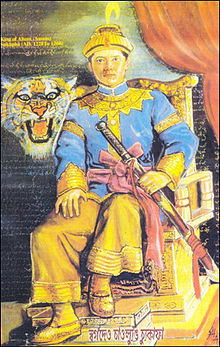
Back চ্যু-কা-ফা Assamese সুকাফা Bengali/Bangla Sukaphaa Spanish छो लुंग सुकफा Hindi Sukaphaa ID ᱥᱩᱠᱟᱯᱷᱟ SAT சுகபா Tamil เจ้าหลวงเสือก่าฟ้า Thai Секафа Ukrainian 蘇卡法 Chinese
| Sukaphaa | |||||
|---|---|---|---|---|---|
| Chaolung | |||||
 Fictional representation of Sukapha by Pushpa Gogoi[1] | |||||
| Ahom King | |||||
| Reign | 1228–1268[2] | ||||
| Predecessor | Post established | ||||
| Successor | Suteuphaa | ||||
| Born | c. 1189 Mong Mao kingdom (present day Yunan province of China) | ||||
| Died | 1268 (aged 78-79) Charaideo, Ahom kingdom (present day India) | ||||
| Burial | |||||
| Spouse |
| ||||
| Issue | Suteuphaa | ||||
| |||||
| House | Su/Tsu (Tiger) clan | ||||
| Dynasty | Ahom dynasty | ||||
| Father | Chao Chang-Nyeu | ||||
| Mother | Blak Kham Sen | ||||
| Religion | Ahom religion | ||||
| Ahom dynasty |
|---|
 |
Sukaphaa (r. 1228–1268), also Siu-Ka-Pha,[3] the first Ahom king in medieval Assam, was the founder of the Ahom kingdom and the architect of Assam. A prince of the Su/Tsu (Tiger) clan of the Mao-Shan sub-tribe[4] originally from present-day Mong Mao, Yunnan Province, China, the kingdom he established in 1228[5] existed for nearly six hundred years and in the process unified the various ethnic groups of the region that left a deep impact on the region. In reverence to his position in Assam's history the honorific Chaolung is generally associated with his name (Chao: lord; Lung: great).
Since 1996, December 2 has been celebrated in Assam as the Sukaphaa Divas, or Asom Divas (Assam Day), to commemorate the advent of the first king of the Ahom kingdom in Assam after his journey over the Patkai Hills.

- ^ Yasmin Saikia (2004), Fragmented memories : struggling to be Tai-Ahom in India. 2004. pp. 242–3.
- ^ Baruah (1986, p. 661)
- ^ "...the advance of the Tais under Sukapha (Siu-Ka-Pha) was a historical fact and is well documented by records and traditions." (Phukan 1992:51)
- ^ "The choice fell on him not only for his qualities as a military leader, but also for his privileged birth in the Chao-pha (noble-celestial) or royal clan from which alone a Tai segmentary society could customarily choose its chief. More precisely, he belonged to the Tiger (Su/Tsu) clan of the Mao-Shan sub-tribe." (Guha 1983:13)
- ^ "...it is not until Sukapha became king in 1228 AD..." (Gait 1906:iv)